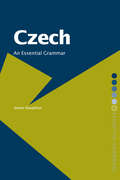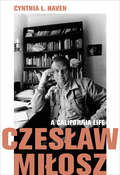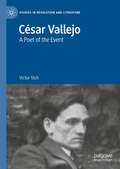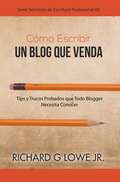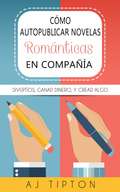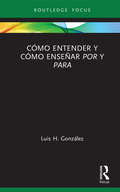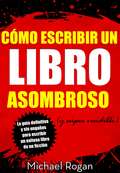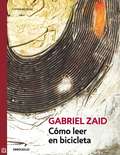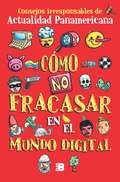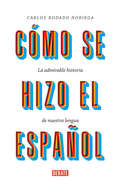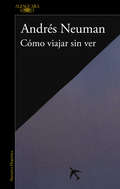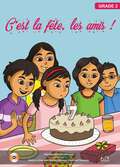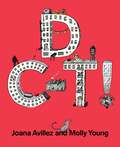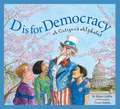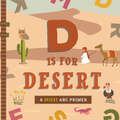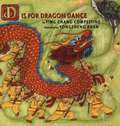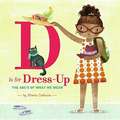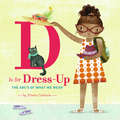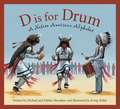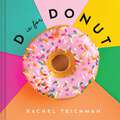- Table View
- List View
Czech: An Essential Grammar (Routledge Essential Grammars)
by James NaughtonCzech: An Essential Grammar is a practical reference guide to the core structures and features of modern Czech. Presenting a fresh and accessible description of the language, this engaging grammar uses clear, jargon-free explanations and sets out the complexities of Czech in short, readable sections. Suitable for either independent study or for students in schools, colleges, universities and adult classes of all types, key features include: * focus on the morphology and syntax of the language* clear explanations of grammatical terms * full use of authentic examples* detailed contents list and index for easy access to information. With an emphasis on the Czech that native speakers use today, Czech: An Essential Grammar will help students to read, speak and write the language with greater confidence.
Czeslaw Milosz: A California Life
by Cynthia L. HavenCzesław Miłosz, one of the greatest poets and thinkers of the past hundred years, is not generally considered a Californian. But the Nobel laureate spent four decades in Berkeley—more time than any other single place he lived—and he wrote many of his most enduring works there. This is the first book to look at his life through a California lens. Filled with original research and written with the grace and liveliness of a novel, it is both an essential volume for his most devoted readers and a perfect introduction for newcomers. Miłosz was a premier witness to the sweep of the twentieth century, from the bombing of Warsaw in World War II to the student protests of the sixties and the early days of the high-tech boom. He maintained an open-minded but skeptical view of American life, a perspective shadowed by the terrors he experienced in Europe. In the light of recent political instability and environmental catastrophe, his poems and ideas carry extra weight, and they are ripe for a new generation of readers to discover them. This immersive portrait demonstrates what Miłosz learned from the Golden State, and what Californians can learn from him.
César Vallejo: A Poet of the Event (Studies in Revolution and Literature)
by Víctor VichThis book argues that the poetry of César Vallejo announces the event, as a moment of irruption of a truth that destabilises the usual state of reality. It studies the emergence of a subject who affirms a truth that exceeds the law, interrupts hegemonic repetition, asserts universal solidarity, and defends "lost causes" despite political failure. The author reconfigures the traditional reading of Vallejo only as a poet of pain and human suffering, and offers new ways of understanding the relationship between poetry and politics.
Cómo Escribir un Blog que Venda
by Richard G Lowe JrHay algo en la manera de escribir un artículo que hace al lector tomar la decisión de hacer algo. Ese es el objetivo de este libro. Aprenderá a crear un artículo que consiga el interés de los lectores, los atraiga, los informe y los lleve a tomar una decisión al terminar la lectura.
Cómo Escribir un Libro Electrónico en un Mes
by Beautrice Norfolk"Cómo Escribir un Libro Electrónico en un Mes: Pasos y Puntos a Considerar, Motivaciones y Creatividad," es una obra que consigue con asombrosa diafanidad potenciar en las personas interesadas en realizar una obra literaria, las habilidades necesarias con sencillas herramientas que permiten explotar el talento que subyace de forma anonima en las personas.
Cómo autopublicar novelas románticas en compañía
by Aj Tipton Daniel García Vázquez¿Quieres divertirte y conseguir dinero autopublicando con tus amigas? Escribir es un trabajo difícil y solitario si se hace sin compañía. Pero no tiene que ser así. Nosotras te ofrecemos un método colaborativo y divertido para autopublicar. Si acabas de adentrarte en el mundo de la autopublicación, ¡esta es la guía que estabas buscando! Cómo autopublicar novelas románticas en compañía es un mapa indispensable que te ayudará a desarrollar todas tus ideas para convertirlas en obras publicadas. Queremos ahorrarte la frustración de trabajar en solitario, haciéndolo todo tú sola. AJ Tipton es un equipo de autoras muy exitoso, y queremos compartir contigo los secretos, consejos y las lecciones que hemos aprendido sobre este mundillo. Este libro incluye: +El mejor método para elegir a tu coautora. +Cómo elegir un género y subgénero +Un método infalible para crear historias que se vendan bien +Una guía para contratar a freelancers para la edición, el diseño de la portada, la traducción, etc. +Consejos de estilo y formato. +Todo lo que tienes que saber sobre las diferentes plataformas: Amazon, Kindle Unlimited, Nook, etc. +Los pros y los contras de traducir tu libro +Como hacer—y usar—un presupuesto +Trucos para promocionar tu libro +El poder de las redes sociales +Cómo llevar una colaboración, dividir tareas, y seguir escribiendo juntas ¡Y mucho más! Si quieres empezar a escribir junto a tus amigas, ¡esta guía paso a paso te será de gran ayuda para comenzar el viaje hacia la autopublicación!
Cómo entender y cómo enseñar por y para
by Luis H. GonzálezCómo entender y como enseñar por y para explora muchos de los problemas que los profesores/as encuentran cuando enseñan el uso de estas dos preposiciones. Este libro proporciona un marco de referencia para la comprensión de las sutilezas entre las dos preposiciones, de manera que los profesores/as podrán ayudarles a los estudiantes a aproximarse a la manera cómo los hablantes nativos/as escogen intuitivamente cuál usar en cualquier situación. Este libro muestra con ejemplos de cuatro autores/as distintos que una regla de punto final intencional (destino, fecha límite, meta, objetivo, propósito, recipiente o uso) explica el 95% de los usos de para. Trescientos ejemplos de Corpes XXI y otros 262 ejemplos de tres novelas distintas muestran que dos reglas (causa e intervalo de espacio/de tiempo) explican el 80% de los usos de por. En este libro no se ejemplifican las reglas; más bien, se formulan desde abajo las reglas necesarias para explicar más de 600 ejemplos auténticos de por o para de novelas y de Corpes XXI. Diseñado para los profesores/as de español como segunda lengua, el procedimiento de construcción de las reglas delineado en el libro mejorará la manera cómo se les enseñará a los estudiantes por y para. Además, las conexiones hechas a través del libro servirán como un modelo para entender mejor otras dicotomías de la gramática del español.
Cómo escribir un libro asombroso (y súper vendible)
by Michael Rogan Victor Hernandez Garcia¿Quieres aprender a escribir un libro asombroso y super vendible… y además ganar dinero con él? ¿Quieres convertir tus ideas creativas y tu experiencia en una fuente confiable e inagotable de dinero? ¿Buscas una guía sin mentiras y súper sencilla para convertir las palabras que tienes en la mente en un texto que las personas pagarán por leer? Bien, pues en “Cómo escribir un libro asombroso (y súper vendible)”, descubrirás: • Las tres claves para encontrar una idea para escribir un asombroso libro de no ficción • Consejos de investigación para las personas que odian investigar • La guía definitiva para crear un título sorprendente y súper vendible • Cómo escribir libros que la gente ame …¡Y muchísimo más! Cada capítulo incluye pasos fáciles de seguir que te ayudarán a impulsar tu escritura sin tener que tomar ni un solo curso en línea de US$2,000. Empieza ahora mismo tu viaje hacia la excelencia en la escritura de libros de no ficción con “Cómo escribir un libro asombroso (y súper vendible)"
Cómo escribir una historia de amor: Manual sobre el género romántico y sus desafíos
by Fernanda PérezEl primer manual para escribir literatura romántica en castellano. Una serie de tópicos centrales -comienzos, finales, diálogos, lenguaje, erotismo- intercalados con numerosas entrevistas a escritores, tanto del género como de otros ámbitos, para todo aquel interesado en la escritura del amor. "No hay sentimiento más fuerte en nuestra especie humana que el amor, y no hay tampoco sentimiento más complejo. No se puede definir, no se puede encasillar, no se puede limitar." El género romántico vive hace algunos años una etapa de renacimiento; ha recuperado mucho espacio en las mesas de las librerías y, también, en las preferencias de los lectores, siendo uno de los más buscados y leídos hoy. Novelas, cuentos, poesía, películas, series y obras de teatro han renovado su pacto con el amor, ese tema inagotable que nos convoca a todos sin excepción. En este manual sobre el género y sus desafíos, Fernanda Pérez -reconocida periodista y autora también de novelas románticas- propone revisar algunas de las cuestiones centrales a la hora de escribir sobre el amor: los comienzos y los finales, los personajes, el lenguaje, el erotismo, el contexto histórico o contemporáneo y, además, los desafíos más actuales, como el feminismo o los estereotipos de lo femenino. A lo largo del libro, numerosas entrevistas con escritoras referentes del género, como Florencia Bonelli, Cristina Bajo, Viviana Rivero, Gloria Casañas, pero también con autores de otros ámbitos como Mauricio Kartún, Liliana Heker o Alejandro Parisi, agregan matices, métodos de trabajo y recorridos de lectura que sirven de guía para todo interesado en escribir sobre el eterno tema del amor.
Cómo grabar audiolibros
by George Smolinski M. Celeste Espina¡El audio es fantástico! No es ninguna novedad el hecho de que, ya sea en podcast o en audiolibros, la gente prefiere escuchar contenido más que verlo o leerlo. ¡Comience a grabar su propio audiolibro! Esta es una completa guía con instrucciones en video que le permitirán crear su propio producto. ¡Lo sé porque yo utilicé ÉSTAS MISMAS TÉCNICAS para grabar este libro para Audible! Los audiolibros son hoy la tendencia más candente en edición. Hubo un crecimiento explosivo en las ventas de audiolibros durante los últimos cuatro años, y hoy usted necesita tener su libro en este formato. Esta guía le enseñará los pormenores de la creación de audiolibros, ¡incluso si desea hacer la grabación usted mismo! Ésta guía abarca: 1. Qué equipamiento necesitará para la grabación y narración de su libro. 2. Cómo comenzar a grabar con los softwares GarageBand y Audacity. 3. Trucos y consejos para ayudarlo a comenzar con buen pie en la narración de audiolibros. 4. Cómo subir su libro terminado a Audible y a iTunes. 5. Recursos útiles para externalizar su producción en el caso de que usted no sea una persona hábil para el "hágalo usted mismo". ¡Súbase al carro de los audiolibros y aprenda a realizarlos hoy mismo!
Cómo leer en bicicleta
by Gabriel ZaidEsta recopilación de artículos se ha convertido, con el paso del tiempo, en una referencia inevitable cuando se habla de la renovación del género ensayístico en Hispanoamérica. Este "es un libro alegre, juguetón, por momentos soberbiamente irresponsable, que tiene la capacidad, más bien infrecuente en la literatura de nuestros días, de excitar la inteligencia y provocar carcajadas al mismo tiempo. Zaid ha conseguido sortear los lugares comunes del artículo cultural corriente, y sus ensayos son sistemáticamente anticonvencionales. [...] Otra virtud que tiene el uso irresponsable (es decir, lúdico) del saber científico en materia de literatura -aparte de producir textos brillantes y divertidos- es que proporciona una especie de alivio. A quienes creen que en esta era de computadoras y robots inteligentísimos la literatura puede desaparecer como quehacer humano al recibir el impacto de la ciencia, los ensayos de Zaid les demuestran que no hay nada que temer. Si la colisión se produce, al menos en este caso, es el supuesto Frankenstein el que se desintegra al tocar la mariposa, es la ciencia la que se vuelve poesía". Mario Vargas Llosa
Cómo leer y escribir poesía / El arte de perdurar
by Hugo Hiriart«Hiriart es nuestro gran ingenio y cualquier literatura mayor lo tendría, como lo tenemos nosotros, entre sus glorias vivas. Es didáctico, es mayéutico, es el antimaestro ante el Altísimo, además de ser persona sobria y especulador intransigente, disperso y mordaz.» Christopher Domínguez Michael Además de ser un magnífico poeta, narrador y dramaturgo, Hugo Hiriart fue un prolífico ensayista. Este segundo volumen de su biblioteca en Debolsillo incluye las obras El arte de perdurar, una serie de ensayos en los que el autor reflexiona en torno a la valía de una obra y la tan fluctuante posteridad, y Cómo leer y escribir poesía, una especie de manual introductorio al arte poética que reúne a clásicos y contemporáneos a través de ejemplos que ilustran la riqueza de nuestro idioma.
Cómo no fracasar en el mundo editorial: Consejos irresponsables de Actualidad Panamericana
by Actualidad panamericanaLos lectores descubrirán cómo en cuatro años Actualidad Panamericana logró posicionarse como una marca digital a punta de afecto y bacanería. ¿Tuvieron que venderle el alma al demonio (o a Facebook) para triunfar en Internet? ¿Es posible llevar gente a un sitio web sin usar titulares engañosos? ¿Cómo han mantenido la motivación mientras consiguen que su audiencia crezca? ¿Cómo logran expresar lo que quieren decir y que la gente lo entienda? ¿Cómo eligen el mejor contenido y los canales por donde llegará más lejos? ¿Cómo superan el miedo al fracaso y a ofender a otros? En este libro, los creadores de Actualidad Panamericana responden a estas preguntas, entre muchas otras, y revelan todo lo que sus lectores siempre han querido saber sobre ellos. Cada día, miles de nuevos medios digitales se lanzan a las turbulentas aguas de Internet a perseguir ese monstruo mitológico llamado éxito. Son muchos los peligros y errores que pueden llevar al naufragio los sueños de fama y fortuna. Actualidad Panamericana a diario inventa noticias en tono de sátira para criticar los males de nuestra sociedad y, curiosamente, se ha consolidado como uno de los portales independientes con mayor credibilidad del país. Acá se comparten todos los secretos -muchas veces en contravía de lo que los gurús de Internet recomiendan- que lo han llevado a ser uno de los medios con más seguidores en Colombia.
Cómo se hizo el español: La admirable historia de nuestra lengua
by Carlos Rodado NoriegaLa admirable historia de nuestra lengua A pesar de lo fascinante que resulta la historia del español, se cree que es una materia reservada para filólogos y lingüistas. El libro de Carlos Rodado Noriega demuestra lo contrario; está escrito para todos, no entra en tecnicismos ni requiere de conocimientos previos, se lee como un relato sugestivo y posible de alcanzar en el que, a través de palabras, mapas e imágenes, reconstruye la formación y evolución de nuestra lengua. Esta admirable historia comienza con los antiguos tartesios y, por la rueda del destino, llega hasta nosotros, los hablantes del español en América.
Cómo viajar sin ver
by Andrés NeumanUn cruce entre la narrativa más actual y la crónica relámpago. Una visión literaria, al vuelo, de la geografía entera de la lengua. Reflexionando sobre el escaso tiempo previsto para recorrer cada país con el Premio Alfaguara, el autor se pregunta si hoy nuestros viajes consisten sobre todo en no ver. «¿Estaré por experimentar una hipérbole del turismo contemporáneo?», escribe. Pero el ritmo radical de su periplo está a punto de brindarle una oportunidad única: comparar todas las capitales latinoamericanas en una misma ráfaga. Andrés Neuman nos propone un recorrido vertiginoso por 19 países, interpretados por un ojo poético y político. Los presuntos no-lugares (aeropuertos, hoteles, taxis) quedan así convertidos en poderosos espacios de conflicto. Explorando con agudeza los dilemas de la identidad nacional y las contradicciones de la globalización, Cómo viajar sin ver es un diario innovador y divertido que experimentacon las formas de nuestro tiempo. Y que le toma el pulso a la vida cultural del continente, abordando no solamente a sus clásicos sino también a las nuevas generaciones de creadores. Un libro esencial para cualquier persona interesada en la historia, la actualidad y el futuro de Latinoamérica. Una manera distinta de pensar nuestra cultura cambiante y el sentido del viaje. Críticas:«A partir de ahora, todo viajero curioso que recorra Latinoamérica debería llevar consigo este libro portátil, apasionante y verdadero, de alguien que sabe oír y mirar sin prejuicios, con la lucidez que le proporciona su visión generosa.» Fernando Valls, Ínsula «Una obra estupenda. [...] Una América tan compleja, tan variada [...] que el lector piensa que no hay ficción capaz de competir con una realidad que parece albergarla.»José María Pozuelo Yvancos, ABC «En El viajero del siglo, por el que ha recibido el Premio de la Crítica, Neuman revisitaba la novela del siglo XIX, el viaje de ida; y del resultado de su gira ha nacido una narración del XXI: una antítesis, una cara B.»Ulises Fuentes, La Razón «Un libro de chispazos que no está edificado sobre la frivolidad o la brillantez visual, sino sobre la perspicacia de la mirada. Neuman tiene unas gafas que son sólo suyas, y a través de ellas miramos.»Luisgé Martín, Gente «Los fogonazos de Neuman iluminan Latinoamérica. El escritor radiografía la diversidad del continente.»Paula Corroto, Público «Su aguda percepción se renueva en cada aterrizaje. Aflora la magia viajera del autor, la calidad de un escritor como Andrés Neuman.»Gabriel Cetkovich, Clarín (Argentina) «Un conjunto de instantáneas divertidas, fugaces, conmovidas y conmovedoras, deslumbrantes destellos de una pluma privilegiada.»Guillermo Roz, Periodista Digital «Una virtuosa demostración de escritura al vuelo. Altamente observador, Neuman se concentra en cada instante y captura pequeños detalles que a otros escritores se les habrían escapado [...] Un vertiginoso retrato de Latinoamérica en todas sus miserias y glorias.»Kirkus Reviews (EE. UU.) «No se trata de una literatura de viajes convencional, y sin embargo el libro funciona. Eso es gracias al ojo de Neuman para el absurdo y la ironía. Más importante aún es su talento para lo sucinto. Lugares y personas quedan capturados en una sola, atinada frase [...]. Pese a los kilómetros que recorre, se regocija en la quietud, ya que su gran pasión es la lectura.»Oliver Balch, The Spectator (Reino Unido)
C’est la fête, les amis! class 2 - MIE
by Kaviraj. S. PeedolyLe livre "C’est la fête, les amis!" rédigé par Kaviraj. S. Peedoly et illustré par William Rasoanaivo, est un récit captivant qui relate la joyeuse célébration de l'anniversaire d'Aaliya et de la Journée de l'Indépendance de l'île Maurice. L'histoire se déroule alors qu'Aaliya invite avec enthousiasme ses camarades de classe à se joindre à sa célébration, débutant par l'hymne national dans le jardin, en commémoration de l'indépendance du pays. Le récit capte l'excitation de couper le gâteau d'anniversaire, de recevoir des cadeaux et de savourer de délicieuses gourmandises. Conçu comme un livre géant interactif, les sessions sont structurées de manière réfléchie, encourageant les discussions pré-lecture sur les thèmes de l'indépendance et des anniversaires. Les sessions engageantes du livre permettent aux élèves d'explorer la compréhension linguistique à travers des discussions de groupe, de se remémorer des expériences personnelles liées aux thèmes, et de favoriser des activités créatives telles que le coloriage. À travers des illustrations vibrantes et une narration accessible, le livre vise à promouvoir la littératie et la compréhension culturelle parmi les jeunes apprenants à Maurice, offrant une plateforme interactive pour renforcer les compétences linguistiques tout en célébrant des événements précieux.
D C-T!
by Joana Avillez Molly YoungA joy-inducing illustrated book about New York City in the ingenious style of William Steig's classic CDB!Just as there are few cities as storied and replete with life as New York City, there are few illustrators or writers who have charmed as many generations as William Steig. To Molly Young and Joana Avillez, a connection between the two seemed obvious, and so D C-T! ("The City!") was born.Using a playful phonetic language first invented by Steig in his now classic 1968 book CDB!--but which in today's world of text message and internet shorthand feels uncannily contemporary--Young and Avillez tell a different story on each page of this collection of illustrations stuffed to brim with humor and cleverness:"S L-I-F!" (It's alive!) A boy shouts gleefully at a pile of rubbish seething with rats"I M B-Z" (I'm busy) Declares the phone-wielding businesswoman to the would-be mugger"R U I?" (Are you high?) Asks the clerk at a bodega to the blissed out shopperBrought to life in Avillez's distinctively ebullient and droll style are precocious pets and pet-owners, iconic architecture, and startlingly intrepid anthropomorphic rats. At once recognizable, and imagined like never before, are the surprising, intoxicating, and not-always-entirely-welcome sights, sounds, and smells of New York City. Full of wit, romance, and sheer delight, D C-T! is both an affectionate portrait of the visual cornucopia that is New York City and a gracious love letter to the great William Steig, sure to enchant readers young and old alike just as his work has for half a century.
D Is For Democracy: An American Citizen's Alphabet
by Elissa GrodinDemocracy--America has it and it seems like many other countries want it. But what exactly is a democracy and how easy is it to maintain? Despite the banter in today's media, many Americans are still in the dark when it comes to knowing and acting upon their rights and responsibilities as citizens of a democratic society in refreshingly candid and straight-to-the-point language author Elissa Grodn takes readers of all ages on an A-Z trip through our government's structure, from its earliest beginnings to definitions of basic components and concepts (including immigration and taxation). Engaging, disarming, and frequently thought-provoking artwork from illustrator Victor Juhasz emphasizes the magnitude of the subject. From founding fathers, first ladies, and the First Amendment to the presidential oath of office, D is for Democracy details the political processes, parties, and people of democracy. American style.
D Is for Desert: An ABC Desert Primer
by Ashley Marie MirelesA is for armadillo B is for bedrock C is for cactus . . . With E for erosion, I for iguana, and P for prickly pear, going from A to Z has never been more fun in the sun! Take an alphabetized trip through the dunes and discover the plants, animals, and weather patterns that make the deserts of the world so amazing!
D Is for Dragon Dance
by Ying Chang CompestineA is for Acrobats. B is for Balls. C is for Calligraphy. D is for Dragon Dance. From firecrackers to noodles, from red envelopes to the zodiac, young readers are introduced to the exciting traditions of the Chinese New Year.
D Is for Dress Up
by Maria CarluccioMaria Carluccio's playful fashion alphabet celebrates the fun of getting dressed--and getting dressed up! From a sophisticated bow tie to a warm wool hat, this diverse celebration of what we wear from A to Z invites kids to get creative and embrace their own unique style.
D Is for Dress Up: The ABC's of What We Wear
by Maria CarluccioMaria Carluccio's playful fashion alphabet celebrates the fun of getting dressed—and getting dressed up! From a sophisticated bow tie to a warm wool hat, this diverse celebration of what we wear from A to Z invites kids to get creative and embrace their own unique style. Plus, this is the fixed-format version, which looks almost identical to the print edition!
D Is for Drum: A Native American Alphabet
by Michael Shoulders Debbie ShouldersReaders get an A-Z introduction to the customs and cultures of the first people inhabiting the Americas. Topics include Bison, tipis, Kachinas, and dugout canoes.
D is for Donut (ABCD-Eats)
by Rachel Teichman Rebecca Wright Rachel TiechmanDeliciously delightful donuts from A to Z!“ A is for Apple Fritter” and “ B is for Beignet.” Get ready to dive into this mouthwatering alphabet book that will surely sweeten your day! Lively rhyming text covers all the classics, from Jelly and Rainbow Sprinkles to É clairs and Old-Fashioneds, while introducing Loukoumades, Sufganiyot, and other donuts from around the world. Life-size photos look ready to eat and keep readers asking for more. Practicing your ABCs never looked so yummy!
D is for Duck!
by David MellingCome on an alphabet adventure with Duck in this brilliantly funny story from the bestselling creator of Hugless Douglas.Duck is a magician. Abracadabra! He can conjure up a bunny, a chicken and even the king of the jungle. But can he make a dragon disappear?David Melling is one of the UK's best-loved author-illustrators and his stories combine brilliantly imaginative illustrations and unforgettable characters.'A new Hugless Douglas book is always a cause for celebration.' Daily Mail
